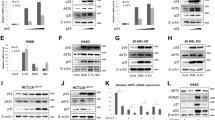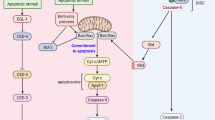Abstract
P53-induced protein with a death domain (PIDD) has been described as primary p53 target gene, induced upon DNA damage. More than 10 years after its discovery, its physiological role in the DNA damage response remains enigmatic, as it seems to be able to execute life–death decisions in vitro, yet genetic ablation in mice failed to reveal an obvious phenotype. Nonetheless, evidence is accumulating that it contributes to the fine-tuning of the DNA-damage response by orchestrating critical processes such as caspase activation or nuclear factor κB translocation and can also exert additional nuclear functions, for example, the modulation of translesion synthesis. In this review, we aim to integrate these observations and propose possible unexplored functions of PIDD.
This is a preview of subscription content, access via your institution
Access options
Subscribe to this journal
Receive 50 print issues and online access
$259.00 per year
only $5.18 per issue
Buy this article
- Purchase on Springer Link
- Instant access to full article PDF
Prices may be subject to local taxes which are calculated during checkout


Similar content being viewed by others
References
Jackson SP, Bartek J . The DNA-damage response in human biology and disease. Nature 2009; 461: 1071–1078.
Vousden KH, Lane DP . p53 in health and disease. Nat Rev Mol Cell Biol 2007; 8: 275–283.
Meek DW . Tumour suppression by p53: a role for the DNA damage response? Nat Rev Cancer 2009; 9: 714–723.
Olsson A, Manzl C, Strasser A, Villunger A . How important are post-translational modifications in p53 for selectivity in target-gene transcription and tumour suppression? Cell Death Differ 2007; 14: 1561–1575.
Lin Y, Ma W, Benchimol S . Pidd, a new death-domain-containing protein, is induced by p53 and promotes apoptosis. Nat Genet 2000; 26: 122–127.
Telliez JB, Bean KM, Lin LL . LRDD, a novel leucine rich repeat and death domain containing protein. Biochim Biophys Acta 2000; 1478: 280–288.
Tinel A, Janssens S, Lippens S, Cuenin S, Logette E, Jaccard B et al. Autoproteolysis of PIDD marks the bifurcation between pro-death caspase-2 and pro-survival NF-kappaB pathway. Embo J 2007; 26: 197–208.
Janssens S, Tinel A, Lippens S, Tschopp J . PIDD mediates NF-kappaB activation in response to DNA damage. Cell 2005; 123: 1079–1092.
Logette E, Schuepbach-Mallepell S, Eckert MJ, Leo XH, Jaccard B, Manzl C et al. PIDD orchestrates translesion DNA synthesis in response to UV irradiation. Cell Death Differ 2011; 18: 1036–1045.
Tinel A, Tschopp J . The PIDDosome, a protein complex implicated in activation of caspase-2 in response to genotoxic stress. Science 2004; 304: 843–846.
Pick R, Badura S, Bosser S, Zornig M . Upon intracellular processing, the C-terminal death domain-containing fragment of the p53-inducible PIDD/LRDD protein translocates to the nucleoli and interacts with nucleolin. Biochem Biophys Res Commun 2006; 349: 1329–1338.
Cuenin S, Tinel A, Janssens S, Tschopp J . p53-induced protein with a death domain (PIDD) isoforms differentially activate nuclear factor-kappaB and caspase-2 in response to genotoxic stress. Oncogene 2008; 27: 387–396.
Huang L, Han D, Yang X, Qin B, Ji G, Yu L . PIDD4, a novel PIDD isoform without the LRR domain, can independently induce cell apoptosis in cytoplasm. Biochem Biophys Res Commun 2011; 407: 86–91.
Heinz LX, Rebsamen M, Rossi DC, Staehli F, Schroder K, Quadroni M et al. The death domain-containing protein Unc5CL is a novel MyD88-independent activator of the pro-inflammatory IRAK signaling cascade. Cell Death Differ 2011 (e-pub ahead of print 9 December 2011; doi:10.1038/cdd.2011.147).
Rosenblum JS, Blobel G . Autoproteolysis in nucleoporin biogenesis. Proc Natl Acad Sci U S A 1999; 96: 11370–11375.
Manzl C, Krumschnabel G, Bock F, Sohm B, Labi V, Baumgartner F et al. Caspase-2 activation in the absence of PIDDosome formation. J Cell Biol 2009; 185: 291–303.
Tinel A, Eckert MJ, Logette E, Lippens S, Janssens S, Jaccard B et al. Regulation of PIDD auto-proteolysis and activity by the molecular chaperone Hsp90. Cell Death Differ 2011; 18: 506–515.
Li J, Yuan J . Caspases in apoptosis and beyond. Oncogene 2008; 27: 6194–6206.
Pop C, Salvesen GS . Human caspases: activation, specificity, and regulation. J Biol Chem 2009; 284: 21777–21781.
Read SH, Baliga BC, Ekert PG, Vaux DL, Kumar S . A novel Apaf-1-independent putative caspase-2 activation complex. J Cell Biol 2002; 159: 739–745.
Krumschnabel G, Sohm B, Bock F, Manzl C, Villunger A . The enigma of caspase-2: the laymen's view. Cell Death Differ 2009; 16: 195–207.
Duan H, Dixit VM . RAIDD is a new ‘death’ adaptor molecule. Nature 1997; 385: 86–89.
Niizuma K, Endo H, Nito C, Myer DJ, Kim GS, Chan PH . The PIDDosome mediates delayed death of hippocampal CA1 neurons after transient global cerebral ischemia in rats. Proc Natl Acad Sci U S A 2008; 105: 16368–16373.
Hasegawa H, Yamada Y, Tsukasaki K, Mori N, Tsuruda K, Sasaki D et al. LBH589, a deacetylase inhibitor, induces apoptosis in adult T-cell leukemia/lymphoma cells via activation of a novel RAIDD-caspase-2 pathway. Leukemia 2011; 25: 575–587.
Vakifahmetoglu H, Olsson M, Orrenius S, Zhivotovsky B . Functional connection between p53 and caspase-2 is essential for apoptosis induced by DNA damage. Oncogene 2006; 25: 5683–5692.
Olsson M, Vakifahmetoglu H, Abruzzo PM, Hogstrand K, Grandien A, Zhivotovsky B . DISC-mediated activation of caspase-2 in DNA damage-induced apoptosis. Oncogene 2009; 28: 1949–1959.
Sidi S, Sanda T, Kennedy RD, Hagen AT, Jette CA, Hoffmans R et al. Chk1 suppresses a caspase-2 apoptotic response to DNA damage that bypasses p53, Bcl-2, and caspase-3. Cell 2008; 133: 864–877.
Kim IR, Murakami K, Chen NJ, Saibil SD, Matysiak-Zablocki E, Elford AR et al. DNA damage- and stress-induced apoptosis occurs independently of PIDD. Apoptosis 2009; 14: 1039–1049.
Bergeron L, Perez GI, Macdonald G, Shi L, Sun Y, Jurisicova A et al. Defects in regulation of apoptosis in caspase-2-deficient mice. Genes Dev 1998; 12: 1304–1314.
Ho LH, Read SH, Dorstyn L, Lambrusco L, Kumar S . Caspase-2 is required for cell death induced by cytoskeletal disruption. Oncogene 2008; 27: 3393–3404.
Ho LH, Taylor R, Dorstyn L, Cakouros D, Bouillet P, Kumar S . A tumor suppressor function for caspase-2. Proc Natl Acad Sci U S A 2009; 106: 5336–5341.
Berube C, Boucher LM, Ma W, Wakeham A, Salmena L, Hakem R et al. Apoptosis caused by p53-induced protein with death domain (PIDD) depends on the death adapter protein RAIDD. Proc Natl Acad Sci U S A 2005; 102: 14314–14320.
Janssens S, Tschopp J . Signals from within: the DNA-damage-induced NF-kappaB response. Cell Death Differ 2006; 13: 773–784.
Miyamoto S . Nuclear initiated NF-kappaB signaling: NEMO and ATM take center stage. Cell Res 2011; 21: 116–130.
Hayden MS, West AP, Ghosh S . NF-kappaB and the immune response. Oncogene 2006; 25: 6758–6780.
Huang TT, Wuerzberger-Davis SM, Wu ZH, Miyamoto S . Sequential modification of NEMO/IKKgamma by SUMO-1 and ubiquitin mediates NF-kappaB activation by genotoxic stress. Cell 2003; 115: 565–576.
Lee MH, Mabb AM, Gill GB, Yeh ET, Miyamoto S . NF-kappaB induction of the SUMO Protease SENP2: a negative feedback loop to attenuate cell survival response to genotoxic stress. Mol Cell 2011; 43: 180–191.
Wu ZH, Shi Y, Tibbetts RS, Miyamoto S . Molecular linkage between the kinase ATM and NF-kappaB signaling in response to genotoxic stimuli. Science 2006; 311: 1141–1146.
Jin HS, Lee DH, Kim DH, Chung JH, Lee SJ, Lee TH . cIAP1, cIAP2, and XIAP act cooperatively via non-redundant pathways to regulate genotoxic stress-induced nuclear factor-kappaB activation. Cancer Res 2009; 69: 1782–1791.
Stilmann M, Hinz M, Arslan SC, Zimmer A, Schreiber V, Scheidereit C . A nuclear poly(ADP-ribose)-dependent signalosome confers DNA damage-induced IkappaB kinase activation. Mol Cell 2009; 36: 365–378.
Mabb AM, Wuerzberger-Davis SM, Miyamoto S . PIASy mediates NEMO sumoylation and NF-kappaB activation in response to genotoxic stress. Nat Cell Biol 2006; 8: 986–993.
Hinz M, Stilmann M, Arslan SC, Khanna KK, Dittmar G, Scheidereit C . A cytoplasmic ATM-TRAF6-cIAP1 module links nuclear DNA damage signaling to ubiquitin-mediated NF-kappaB activation. Mol Cell 2010; 40: 63–74.
Yang Y, Xia F, Hermance N, Mabb A, Simonson S, Morrissey S et al. A cytosolic ATM/NEMO/RIP1 complex recruits TAK1 to mediate the NF-kappaB and p38 mitogen-activated protein kinase (MAPK)/MAPK-activated protein 2 responses to DNA damage. Mol Cell Biol 2011; 31: 2774–2786.
Wu ZH, Wong ET, Shi Y, Niu J, Chen Z, Miyamoto S et al. ATM- and NEMO-dependent ELKS ubiquitination coordinates TAK1-mediated IKK activation in response to genotoxic stress. Mol Cell 2010; 40: 75–86.
Karin M, Cao Y, Greten FR, Li ZW . NF-kappaB in cancer: from innocent bystander to major culprit. Nat Rev Cancer 2002; 2: 301–310.
Ben-Neriah Y, Karin M . Inflammation meets cancer, with NF-kappaB as the matchmaker. Nat Immunol 2011; 12: 715–723.
Heinen CD, Schmutte C, Fishel R . DNA repair and tumorigenesis: lessons from hereditary cancer syndromes. Cancer Biol Ther 2002; 1: 477–485.
Bradley G, Tremblay S, Irish J, MacMillan C, Baker G, Gullane P et al. The expression of p53-induced protein with death domain (Pidd) and apoptosis in oral squamous cell carcinoma. Br J Cancer 2007; 96: 1425–1432.
Grosjean-Raillard J, Tailler M, Ades L, Perfettini JL, Fabre C, Braun T et al. ATM mediates constitutive NF-kappaB activation in high-risk myelodysplastic syndrome and acute myeloid leukemia. Oncogene 2009; 28: 1099–1109.
Kerley-Hamilton JS, Pike AM, Li N, DiRenzo J, Spinella MJ . A p53-dominant transcriptional response to cisplatin in testicular germ cell tumor-derived human embryonal carcinoma. Oncogene 2005; 24: 6090–6100.
Oliver TG, Mercer KL, Sayles LC, Burke JR, Mendus D, Lovejoy KS et al. Chronic cisplatin treatment promotes enhanced damage repair and tumor progression in a mouse model of lung cancer. Genes Dev 2010; 24: 837–852.
Oliver TG, Meylan E, Chang GP, Xue W, Burke JR, Humpton TJ et al. Caspase-2-mediated cleavage of Mdm2 creates a p53-induced positive feedback loop. Mol Cell 2011; 43: 57–71.
Sohn D, Budach W, Janicke RU . Caspase-2 is required for DNA damage-induced expression of the CDK inhibitor p21(WAF1/CIP1). Cell Death Differ 2011; 18: 1664–1674.
Acknowledgements
This review is dedicated to the late Jürg Tschopp, who spearheaded research on PIDD, a great scientist, colleague and mentor. Research on PIDD in our laboratory is supported by grants from the Austrian Science Fund (FWF; Y212-B12 and SFB021), EU-FP6 RTN ‘Apoptrain’, the Tyrolean Science Fund (TWF) and the ‘Krebshilfe-Tirol’.
Author information
Authors and Affiliations
Corresponding author
Ethics declarations
Competing interests
The authors declare no conflict of interest.
Rights and permissions
About this article
Cite this article
Bock, F., Peintner, L., Tanzer, M. et al. P53-induced protein with a death domain (PIDD): master of puppets?. Oncogene 31, 4733–4739 (2012). https://doi.org/10.1038/onc.2011.639
Received:
Revised:
Accepted:
Published:
Issue Date:
DOI: https://doi.org/10.1038/onc.2011.639
Keywords
This article is cited by
-
Cold Stress Induces Apoptosis in Silver Pomfret via DUSP-JNK Pathway
Marine Biotechnology (2023)
-
The expression and role of PIDD in retina after optic nerve crush
Journal of Molecular Histology (2020)
-
E1A oncogene induced sensitization to NK cell induced apoptosis requires PIDD and Caspase-2
Cell Death Discovery (2019)
-
PIDD interaction with KEAP1 as a new mutation-independent mechanism to promote NRF2 stabilization and chemoresistance in NSCLC
Scientific Reports (2019)
-
The tumor-modulatory effects of Caspase-2 and Pidd1 do not require the scaffold protein Raidd
Cell Death & Differentiation (2015)



